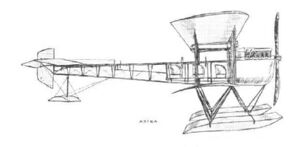Engineering:Astra C
| Astra C | |
|---|---|

| |
| Astra CM Hydro-avion | |
| Role | Sports plane and observation aircraft |
| Manufacturer | Société Astra |
| First flight | 1912 |
The Astra C was a 1912 French single engine biplane, manufactured by Société Astra at Villacoublay. In 1913, the Astra CM Hydro-avion three-seat floatplane version was used to make the world's first scheduled passenger-carrying flights.
Design and development
The Astra C was initially designed as a single seat biplane, powered by a single 50 hp Renault engine in tractor configuration. It was constructed primarily as wooden framework sections, covered in canvas and wire-braced. The fuselage was of triangular cross section, with a wheeled main undercarriage plus nose skid and tail skid. The wings were of unequal span, and employed wing-warping for roll control.[1]
The Astra CM was developed from the Astra C, with a more powerful engine and added accommodation for two observers, for military reconnaissance.[1][2][3]
The Astra Hydro, (an Astra CM 'Hydro-avion' (seaplane)), was a further development in 1913, with a 75 kW (100 hp) Renault V-12 engine and 3 Tellier floats (2 main floats 4.5 m × 1.15 m (14.8 ft × 3.8 ft), and one small tail float). The wooden frame elements were largely replaced by steel tubes, and the wing ribs and floats were the principal remaining wooden components.[4] at least two were built and an order for two from the Royal Navy (RN), serialled 106 and 107, was not completed.[5]
Operational history
During the St. Malo races, 14-26 August 1912, the first CM Hydro was flown to first place by Labouret. The second CM Hydro, powered by a horizontally mounted 82 kW (110 hp) Salmson M.9 water-cooled radial engine, flew at Monaco but crashed.
On 22 March 1913, using at least one Astra CM Hydro-avion, French operator Compagnie générale transaérienne started the world's first scheduled passenger-carrying flights, operating from Cannes to Nice. Two passengers could be carried. On 29 March 1913, the service was extended to Monte Carlo.[6][7]
Variants
- Astra C
- Civil version, with 50 hp Renault engine.[8]
- Astra CM
- Military version, with 75 hp Renault or 75 hp Chenu engine.[8]
- Astra Hydro
- Floatplane version of the Astra CM, with 100 hp Renault engine.[8]
Operators
 France
France
- Compagnie générale transaérienne
 Greece
Greece
- Royal Hellenic Navy
- Hellenic Naval Air Service
Specifications (Astra CM)
General characteristics
- Crew: one pilot
- Capacity: two observers
- Length: 10.97 m (36 ft 0 in)
- Wingspan: 12.32 m (40 ft 5 in)
- Wing area: 48.2 m2 (519 sq ft)
- Empty weight: 673 kg (1,484 lb)
- Gross weight: 1,000 kg (2,200 lb)
- Powerplant: 1 × Renault , 63 kW (85 hp)
Performance
- Maximum speed: 85 km/h (53 mph, 46 kn)
References
- ↑ 1.0 1.1 Parmentier, Bruno (27 May 1998). "Astra CM" (in fr). http://www.aviafrance.com/astra-cm-aviation-france-4490.htm.
- ↑ "Paris Air Show". Flight 3 No. 52 (157): 1130–1137. 30 December 1911. https://www.flightglobal.com/pdfarchive/view/1911/1911%20-%201122.html. Retrieved 8 September 2018.
- ↑ Naughton, Russell. The Pioneers : An Anthology : Astra, Astra-Wright. https://www.ctie.monash.edu.au/hargrave/astra.html. Retrieved 8 September 2018.
- ↑ Flight, 16 November 1912, p. 1053
- ↑ Opdycke, Leonard E. (1999). French Aeroplanes before the Great War. Atglen: Schiffer Publishing Limited. pp. 28-30. ISBN 0-7643-0752-5. https://archive.org/details/frenchaeroplanes00opdy.
- ↑ Taylor, Michael J. H. (1989). Jane's Encyclopedia of Aviation. London: Studio Editions.
- ↑ Jung, Philippe. 2010. Alpes-Maritimes & Monaco Aerospace History
- ↑ 8.0 8.1 8.2 Jane, Fred T. (1969). Jane's all the world's aircraft, 1913. New York: Arco Publishing Co. p. 79. https://catalog.hathitrust.org/Record/009905437.
Bibliography
- Thomas, Andrew. "In the Footsteps of Daedulus: Early Greek Naval Aviation". Air Enthusiast, No. 94, July–August 2001, pp. 8–9. ISSN 0143-5450
Further reading
- Hartmann, Gérard. "Le grand concours d'aviation militaire de Reims 1911". Gérard Hartmann. https://www.hydroretro.net/etudegh/grand_concours_d_aviation_militaire__reims_1911.pdf.
- Moulin, Jean (October 2004). "Reims 1911, le premier concours d'appareils militaires au monde!" (in fr). Avions: Toute l'aéronautique et son histoire (139): 51–58. ISSN 1243-8650.
External links
- Photo Astra CM, Motor 75 hk Renault, Norsk Luftfartsmuseum
- Astra seaplane with Renault V-12 engine (Canada Aviation & Space Museum/Corbis via Getty Images)
- EADS.com - bad link
 |

